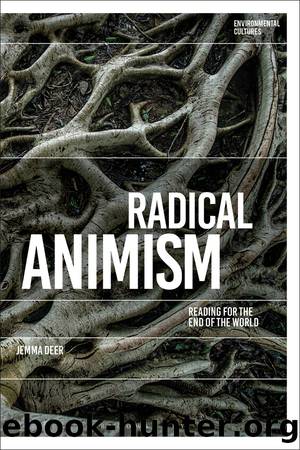Radical Animism by Jemma Deer;

Author:Jemma Deer;
Language: eng
Format: epub
Publisher: Bloomsbury UK
Animal writing: Neither fish nor fowl
Two works that venture toward the alterity of non-human worlds are Helen Macdonaldâs H is for Hawk (2014) â a passage from which opened this chapter â and Nicholas Royleâs Quilt (2010). These books both turn upon the loss of a father and encounters with non-human animals, both are touched by madness and disappearance, and both disturb the threshold between fiction and non-fiction writing. H is for Hawk is Macdonaldâs memoir of working through the grief of losing her father â whilst or by training a goshawk. Royleâs Quilt tells the tale of a man who, after his fatherâs death, adopts â into the latterâs former home â four South American freshwater stingrays. Although H is for Hawk is ânon-fictionâ and Quilt a novel, the two works share many concerns: confluence and incongruence between human and non-human animals; problems of representation; the life of language; the experience of grief and loss; and a preoccupation with or by the auto-bio-graphical, with what Derrida calls âthe writing of the self as livingâ (A, 47).
Let us proceed then, carefully, towards some animals. Here is the first sustained description of Mabel, the goshawk of H is for Hawk:
The feathers down her front are the colour of sunned newsprint, of tea-stained paper, and each is marked darkly towards its tip with a leaf-bladed spearhead, so from her throat to her feet she is patterned with a shower of falling raindrops. Her wings are the colour of stained oak, their covert feathers edged in palest teak, barred flight-feathers folded quietly beneath. And thereâs a strange grey tint to her that is felt, rather than seen, a kind of silvery light like a rainy sky reflected from the surface of a river. She looks new. Looks as if the world cannot touch her. As if everything that exists and is observed rolls off like drops of water from her oiled and close-packed feathers. And the more I sit with her, the more I marvel at how reptilian she is. The lucency of her pale, round eyes. The waxy yellow skin about her Bakelite-black beak. The way she snakes her small head from side to side to focus on distant objects. Half the time she seems as alien as a snake, a thing hammered of metal and scales and glass. But then I see ineffably birdlike things about her, familiar qualities that turn her into something loveable and close. She scratches her fluffy chin with one awkward, taloned foot; sneezes when bits of errant down get up her nose. And when I look again she seems neither bird nor reptile, but a creature shaped by a million years of evolution for a life sheâs not yet lived.48
From the first sentence, we are in the realm of representation: newsprint, paper, stain and mark: the world of surface and trace. Mabel has been drawn upon (and we should remain alert here to the multiple senses of âdrawnâ), her feathers are âmarked darklyâ and âshe is
Download
This site does not store any files on its server. We only index and link to content provided by other sites. Please contact the content providers to delete copyright contents if any and email us, we'll remove relevant links or contents immediately.
The Power of Myth by Joseph Campbell & Bill Moyers(925)
Half Moon Bay by Jonathan Kellerman & Jesse Kellerman(908)
A Social History of the Media by Peter Burke & Peter Burke(879)
Inseparable by Emma Donoghue(844)
The Nets of Modernism: Henry James, Virginia Woolf, James Joyce, and Sigmund Freud by Maud Ellmann(738)
The Spike by Mark Humphries;(719)
The Complete Correspondence 1928-1940 by Theodor W. Adorno & Walter Benjamin(703)
A Theory of Narrative Drawing by Simon Grennan(703)
Ideology by Eagleton Terry;(655)
Bodies from the Library 3 by Tony Medawar(647)
World Philology by(645)
Culture by Terry Eagleton(642)
Farnsworth's Classical English Rhetoric by Ward Farnsworth(641)
A Reader’s Companion to J. D. Salinger’s The Catcher in the Rye by Peter Beidler(612)
Adam Smith by Jonathan Conlin(605)
Game of Thrones and Philosophy by William Irwin(592)
High Albania by M. Edith Durham(589)
Comic Genius: Portraits of Funny People by(581)
Monkey King by Wu Cheng'en(575)
